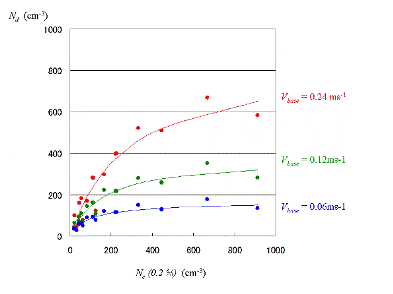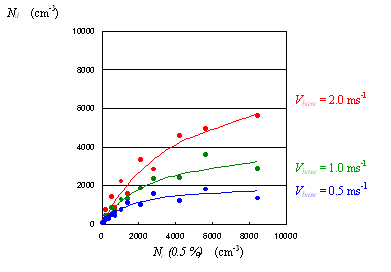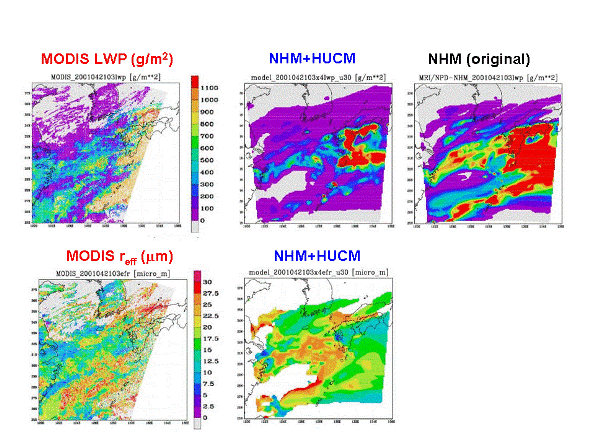2. Warming and atmospheric composition change interaction model developmentResults Page | Top Page |
|||||||
|
2-2 A warming-cloud, aerosol, and radiation feedback precision evaluation The organization name in charge: the Frontier Research System for Global Change
a. SummaryIt aims at developing parameterization for a general circulation model (GCM) estimating the indirect radiation legal force of the influence aerosol affects the optical characteristic of clouds, i.e., troposhere aerosol, into this group. In order to grasp the present condition about evaluation of the indirect radiation legal force of the aerosol in GCM first, literature documentation and examination were performed about CCSR/NIES-GCM and Max Planck Institute-GCM. Moreover, parameterization which evaluates the influence the condensation nucleus (Cloud Condensation Nuclei:CCN) of a cloud particle affects the fine structure of clouds by the detailed cloud physics model (Kuba et al., 2003) developed by the the Frontier Research System for Global Change was developed. In order to operate this parameterization effectively, how to take in the output of SPRINTARS which is an aerosol climate model was examined. As preparation of the detailed cloud physics model loading super-high resolution all ball model development using NICAM (New Icosahediral Atmospheric Model, Satoh, 2003, Tomita, 2002), he is Hebrew University of Jerusalem. Based on the HUCM detailed cloud physics model (Khain et al., 1999) and the Meteorological Agency MRI/NPD-NHM non-statics meso scale model (Saito and Kato, 1999), the 3-dimensional bottle method detailed cloud physics model was newly developed (Inokuchi, 2002). b. Research purposeAs it is also in the report of IPCC2001, the estimate of the indirect radiation legal force of troposhere aerosol is the problem that uncertainty is still large, and the main factor is because aerosol and the relation of clouds are indefinite. Although it works as CCN in aerosol, the particle size distribution of a cloud particle is decided by particle size distribution, chemical composition, and upward flow speed in clouds, the efficiency of precipitation of the optical characteristics, such as reflectance of clouds and optical thickness, the rain ease of coming down, etc. changes, as a result it is effective against radiation balance or a water cycle in climate change prediction. In order to clarify such causal relationship, the numerical simulation by a detailed cloud model is indispensable. In this symbiosis project, parameterization for a general circulation model (GCM) to estimate the influence aerosol affects the optical characteristic of clouds is developed. c. A research program, a method, schedulingparameterization which evaluates the influence CCN affects the fine structure of clouds by the detailed cloud physics model (Kuba et al., 2003) developed by the the Frontier Research System for Global Change is developed. Moreover, in order to bury the scale gap between the grid spacing (time interval of several hours) of 100km scale of GCM, and the time interval for 0.1 seconds of a detailed cloud physics model (grid spacing of several m or less), a super-high resolution all ball model (grid spacing of several km) and a high resolving cloud resolving domain model (grid spacing of tens of m) are required, and carry a cloud physics model in each. It is due to adopt NICAM (New Icosahediral Atmospheric Model, Satoh, 2003, Tomita, 2002) currently developed by the Frontier Research System for Global Change about the super-high resolution all ball model, to mount a basis-function deployment cloud physics model in this, and to make it combine with a SPRINTARS aerosol climate model (Takemura et al., 2000, 2002). As a high resolution domain model, a Meteorological Agency MRI/NPD-NHM non-statics meso scale model (Saito and Kato, 1999) is adopted, and the detailed cloud physics model (Kuba et al., 2003) developed by the Frontier Research System for Global Change is carried. In FY 2002, the development and examination of parameterization which are possible in a detailed cloud physics model independent will be performed. The cloud model to NICAM and each NHM will be carried in FY 2003 〜 2004, comparative experiments will be conducted from FY 2005, and parameterization for GCM will be developed henceforth.
d. The research program in FY 2002First, in order to grasp the present condition about evaluation of the indirect radiation legal force of the aerosol in GCM, CCSR/NIES-GCM and Max Planck Institute-GCM are examined by carrying out literature documentation. Moreover, parameterization which evaluates the influence CCN affects the fine structure of clouds by the detailed cloud physics model (Kuba et al., 2003) developed by the the Frontier Research System for Global Change is developed. In order to operate this parameterization effectively, how to take in the output of SPRINTARS which is an aerosol climate model is examined. Furthermore, a Meteorological Agency MRI/NPD-NHM non-statics meso scale model (Saito and Kato, 1999) and Hebrew University of Jerusalem The newly developed HUCM+NHM model is used based on a HUCM detailed cloud physics model (Khain et al., 1999), the reappearance experiment about the interaction of clouds and aerosol is conducted, and it compares with an observed value. e. Reports in FY 2002Grasp of the present condition about evaluation of the indirect radiation legal force of the aerosol in GCM
Nd = epsilonNaNm/(epsilonNa+Nm) it comes out, and it expresses and is [ come out and ]. However, Na is the total aerosol number density. (total of sulfate, carbon, and sea salt) . The life effect of clouds is expressed with the formula of autoconversion of a cloud particle. There is a formula of Kessler, modified Kessler, Berry, modified Berry, etc. in this.
The upward flow speed in a cloud is found from the average upward flow speed wgrid in a lattice, w = wgrid + c (TKE)1/2 It is carrying out. However, TKE is turbulent kinetic energy. Although the validity of this formula requires examination, in the present condition, the good thing is not advocated [ rather than ] instead of this. Development of parameterization which evaluates the influence CCN affects the fine structure of clouds
By the detailed cloud physics model developed by the the Frontier Research System for Global Change , the effect of CCN to the optical characteristic of the stratus of non-precipitation nature was investigated, and the approximate expression which calculates optical thickness from cloud particle number density and LWP, the approximate expression which calculates the effective radius of the cloud particle of cloud base top each altitude from cloud particle number density, and the approximate expression which calculates cloud particle number density from the degree spectrum of CCN supersaturation and upward flow speed were developed (Kuba et al., 2003). A = 0.121 LWP 0.702 B = 0.274 LWP 0.0538 Effective radius Re (micrometer) of the cloud particle of cloud base top each altitude It is Z about the altitude from a cloud base. When (m), it can express as follows. Re = C NdD (2) C = 6.41 Z 0.380 D = - 0.288 Z 0.0254 Moreover, cloud particle number density can be expressed as follows using the CCN number density Nc (Smax) (cm-3) activated with the degree Smax of the maximum supersaturation in clouds, and the upward flow speed Vbase in a cloud base (ms-1). Nd = min{E (Nc(Smax) - F)(Nc(Smax) - G) , Nc(Smax)} However, Nc(Smax) < 0.5 (F+G) (3) E = - 0.0231Vbase2 - 0.0108 Vbase - 0.00180 F = 70.0 Vbase -12.9 ; G = 8420 Vbase + 278 However, Nc (Smax) = in 0.5 (F+G), Nd is saturated mostly and it is Nd =. 0.25 E(G - F) It is set to 2. The degree of the maximum supersaturation in clouds can be expressed as follows using the CCN number density Nc (0.075%) (cm-3) activated at the 0.075% of the degrees of supersaturation. Smax = H Nc(0.075%)I (4) H = 1.16 Vbase0.344 I = - 0.176 Vbase-0.187 Furthermore, CCN number density Nc (S) (cm-3) which activates cloud particle number density (cm-3) as simple parameterization with the upward flow speed Vbase in a cloud base (ms-1), and the degree S of supersaturation The formula to express was developed (Kuba and Iwabuchi, 2003). Vbase is 0.4 ms-1. When it is the following, Nd = L Nc(0.2%) / ( Nc(0.2%) + M ) (5) L = 4708 Vbase1.19 M = 33.2 + 1090 Vbase Vbase is 0.4 ms-1. When it is above, Nd = L' Nc(0.5%) / ( Nc(0.5%) + M' ) (6) L' = 4300Vbase1.05 M'= 2760 Vbase0.755 The simulation result of these approximate expressions and a detailed cloud physics model is shown in Fig. 1. Although variation is large about 2.0ms-1 in upward flow speed, it is because correlation is small since this has the degree of the maximum supersaturation larger than 0.5% in clouds.
Above figure: The upward flow speed in a cloud base is 0.24, 0.12, and 0.06 ms-1. A solid line is the value which substituted three kinds of upward flow speed for the approximate expression (5). The following figure: The upward flow speed in a cloud base is 2.0, 1.0, and 0.5 ms-1. A solid line is the value which substituted three kinds of upward flow speed for the approximate expression (6). Examination of how to take in the output of SPRINTARS In order to examine how to take in the output of SPRINTARS (Takemura etal., 2000, 2002) which is an aerosol climate model, the formula of cloud particle number density parameterization of Ghan et al. (1997) was included in SPRINTARS+CCSR/NIRES-GCM, the reappearance experiment was conducted, and it compared with the observed value. Since it turned out that cloud particle number density is overestimated, how to ask for CCN number density from the aerosol number density which is the output of SPRINTARS, and the justification of parameterization of Ghan et al. (1997) are examined succeedingly. HUCM+NHM modelAs preparation of the detailed cloud physics model loading super-high resolution all ball model development using NICAM, he is Hebrew University of Jerusalem. Based on the HUCM detailed cloud physics model (Khain et al., 1999) and the Meteorological Agency MRI/NPD-NHM non-statics meso scale model (Saito and Kato, 1999), the 3-dimensional bottle method detailed cloud physics model was newly developed (Inokuchi, 2002). The reappearance result about the interaction of the clouds using this HUCM+NHM model and aerosol is shown in Fig. 2. the itinerant Buddhist of few-stories clouds by whom the figure was got from the TERRA/MODIS satellite loading sensor in the APEX-E2 observation experiment on April 21, 2001 -- a total amount and a cloud particle radius are compared with a model value (Nakajima et al., 2001). The CCN number was presumed here from the aerosol number density distribution on the same day (Takemura et al., 2002) acquired from a SPRINTARS aerosol climate model. The liquid water content simultaneously obtained from an original NHM model is also shown in a figure. Since the detailed cloud physics process of an original NHM model is a bulk method, a cloud particle radius is incalculable. According to the figure, it is shown that distribution of the detailed cloud physical quantity by which the model developed this time was observed is appropriately reproducible. However, in the model, when the liquid water content of another day in an observation period (April 25) and the frequency function of a cloud particle radius were plotted to Fig. 3, unless about 4 times of assumed mass of cloud nucleus were given (modelx4), it became clear that the re-frequency liquid water content which a satellite observed value shows, and a cloud particle radius (MODIS) are also unreproducible. Overestimation of the particle radius by such a model is reported by the perpendicular one plane model (Zhao et al., 2003). In order to solve such a problem from now on, it seems that examination is required also about parameterization for examination to not necessarily form CCN from the aerosol which is not enough.
The figure of the lower berth: The moment value of the cloud particle effective radius (micrometer) in the cloud top in this time. In a central figure, the right figure is the observed value in MODIS picture re-analysis, and as a result of [ by a HUCM+MRI/NPD-NHM model ] calculation. By MRI/NPD-NHM, since a cloud particle effective radius is incalculable explicitly, a figure is not shown. f. ConsiderationIn the present condition, effective parameterization which draws the number density of cloud droplets from the number density of CCN and the number density of CCN is not established from the number density of aerosol,Kuba et al. (2003) -- and -- examination of the application method to GCM of parameterization of Kuba and Iwabuchi (2003) -- requiredTherefore, it is alike.The cloud nucleus physics model loading high resolution domain model which was with development of the detailed cloud physics model loading super-high resolution all ball using は NICAM and the non-statics meso scale model of MRI/NPD-NHM needs to be developed. g. BibliographyGhan, S. J., R. Leung, C. Easter and H. Abdul-Razzak, Prediction of cloud droplet number in a general circulation model, J. Geophys. Res., 102, 21777-21794, 1997.The research on reappearance of the cloud physics characteristic by the cloud face-lift domain model which took in the Iguchi takamichi and cloud nucleus influence, the University of Tokyo master's thesis, and 2002. Khain, A. P., A. Pokrovsky and I. Sednev, Some effects of loud-aerosol interaction on cloud microphysics structure and precipitation formation: numerical experiments with a spectral microphysics cloud ensemble model, Atmos. Res., 52, 195-220, 1999. Kuba, N., H. Iwabuchi, K. Maruyama, T. Hayasaka, T. Takeda and Y. Fujiyoshi, Parameterization of the effect of cloud condensation nuclei on optical properties of a non-precipitating water layer cloud, J. Meteorol. Soc. Japan, 81, 393-414, 2003. Kuba, N. and H. Iwabuchi, Revised parameterization to predict cloud droplet number concentration and a retrieval method to predict CCN number concentration, J. Meteorol. Soc. Japan, submitted, 2003. Lohmann, U., J. Feicher, C. C. Chuang and J. E. Penner, J. Goephys. Res., 104, 9169-9198, 1999. Nakajima, T. Y., A. Uchiyama, T. Takamura and T. Nakajima, Inter-comparisons of warm cloud properties obtained from satellite, ground, and aircraft equipment during AREX and ACE-ASIA period in 2001. J. Geophys. Res., submitted. 2001 Saito, K., and T. Kato, The MRI mesoscale nonhydrostatic model, Met. Res. Note, 196, 169-195, 1999. Satoh, M., Conservative scheme for a compressible non-hydrostatic models with moist processes, Mon. Wea. Rev., 131, 1033-1050, 2003. Tomita, H. Satoh,M., and Goto, K., An optimization of the icosahedral grid modified by the spring dynamics, J. Comput. Phys., 183, 307-331, 2002. Takemura, T., H. Okamoto, Y. Maruyama, A. Numaguti, A. Higurashi, and T. Nakajima, Global three-dimensional simulation of aerosol optical thickness distribution of various origins J. Geophys. Res., 105, 17853-17873, 2000. Takemura, T., T. Nakajima, O. Dubovik, B. N. Holben, and S. Kinne, Single-scattering albedo and radiative forcing of various aerosol species with a global three-dimensional model, J. Climate, 15, 333-352, 2002. Takemura, T., I. Uno, T. Nakajima, A. Higurashi, and I. Sano, Modeling study of long-range transport of Asian dust and anthropogenic aerosols from East Asia, Geophys. Res. Lett., 29, 2158, doi:10.1029/2002GL016251, 2002. Zhao, C.-S., Y. Ishizaka, and R. Kazaoka, Modeling of marine stratocumulus during APEX/ACE-Asia: the role of initial CCN concentration, J. Geophys. Res., submitted, 2003. h. The announcement of a result<Paper announcement>Kuba, N., H. Iwabuchi, K. Maruyama, T. Hayasaka, T. Takeda and Y. Fujiyoshi, Parameterization of the effect of cloud condensation nuclei on optical properties of a non-precipitating water layer cloud, J. Meteorol. Soc. Japan, 81, 2,393-414, 2003. Kuba, N. and H. Iwabuchi, The revised parameterization to predict cloud droplet number concentration and the retrieval method to predict CCN number concentration, J. Meteorol. Soc. Japan, submitted, 2003. Next Page (3. Cryospheric model development) |



